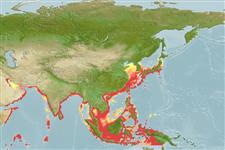Preferred temperature (Ref.
123201): 21.9 - 29.1, mean 28.1 °C (based on 1636 cells).
Phylogenetic diversity index (Ref.
82804): PD
50 = 0.5313 [Uniqueness, from 0.5 = low to 2.0 = high].
Bayesian length-weight: a=0.01820 (0.01405 - 0.02357), b=3.02 (2.95 - 3.09), in cm total length, based on LWR estimates for this species (Ref.
93245).
Nível Trófico (Ref.
69278): 3.3 ±0.1 se; based on diet studies.
Resiliência (Ref.
120179): Médio, tempo mínimo de duplicação da população 1,4 - 4,4 anos (K=0.24-0.26; tmax=7; Fec=5,470).
Prior r = 0.57, 95% CL = 0.37 - 0.85, Based on 9 data-limited stock assessments.
Fishing Vulnerability (Ref.
59153): Low to moderate vulnerability (31 of 100).
🛈
Climate Vulnerability (Ref.
125649): Moderate to high vulnerability (48 of 100).
🛈
Nutrients (Ref.
124155): Calcium = 30.2 [12.9, 71.1] mg/100g; Iron = 0.423 [0.222, 1.065] mg/100g; Protein = 18 [17, 19] %; Omega3 = 0.264 [0.154, 0.448] g/100g; Selenium = 68.2 [22.3, 198.9] μg/100g; VitaminA = 7.21 [1.85, 26.63] μg/100g; Zinc = 0.442 [0.263, 0.770] mg/100g (wet weight); based on
nutrient studies. 